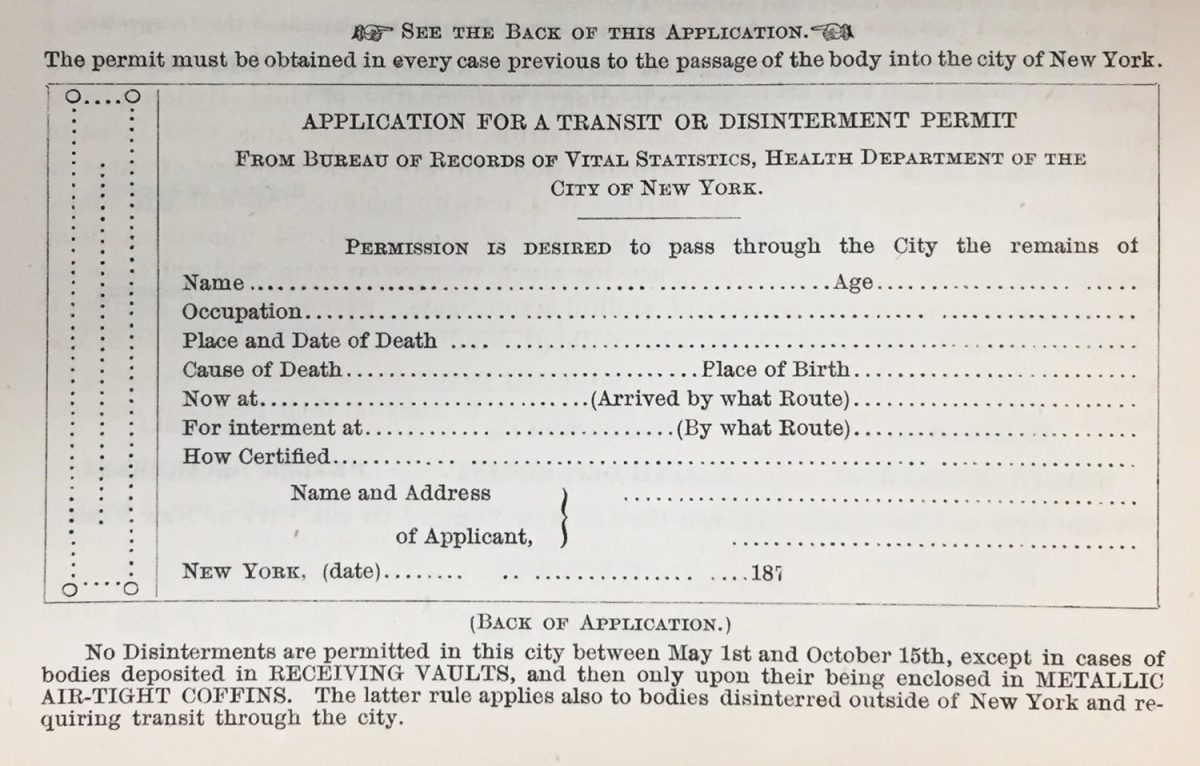Burial transit records provide valuable information for genealogists looking to trace their family history. These records document the transportation of a deceased individual’s remains from the place of death to the place of burial. In New York City, for example, burial transit records are available from 1846 to 1948 and can be obtained from the New York City Municipal Archives.
Burial transit records were created by health departments as a means of monitoring the movement of deceased individuals and ensuring that proper burial procedures were followed. In the late 19th and early 20th centuries, there was growing concern about the spread of disease and the potential health hazards associated with improper burial practices. To address these concerns, health departments began requiring that burial transit records be filed whenever a deceased individual was transported from the place of death to the place of burial.
By creating burial transit records, health departments could track the movement of deceased individuals and ensure that they were buried in a timely and appropriate manner. The records also provided a means of monitoring burial practices and ensuring that they complied with health regulations. For example, burial transit records might include information on the type of casket used, the condition of the body, and whether or not the body had been embalmed.
The following information can typically be found on a burial transit record:
- Name: The name of the deceased individual is listed on the burial transit record.
- Age: The age of the deceased individual is listed on the burial transit record. This should help provide an approximate date of birth.
- Occupation: The occupation of the deceased individual may be listed on the burial transit record. This information can be useful in understanding the economic circumstances of ancestors’ lives.
- Place and Date of Death: The place and date of death of the deceased individual is listed on the burial transit record. This information can be useful in tracing the movement of ancestors over time. It is important to remember that the individual may only have been visiting a location at the time of their death.
- Cause of Death: The cause of death of the deceased individual is listed on the burial transit record. This information can provide additional context and help in understanding possible medical issues that can be genetically inherited.
- Place of Birth: The place of birth of the deceased individual is listed on the burial transit record. This information can be useful in identifying
- By what route did body arrive: The mode of transportation used to transport the deceased individual’s remains is listed on the burial transit record. This can provide insight into the transportation infrastructure of the time period and the social and economic status of the deceased.
- Location of internment: The location of the deceased individual’s internment is listed on the burial transit record. This can be useful in identifying possible burial locations for other family members.
- By what route will body go to place of internment: The mode of transportation used to transport the deceased individual’s remains to the place of internment is listed on the burial transit record.
- Name and Address of applicant: The name and address of the person who applied for the burial transit record is listed on the record. This person is most often related to the deceased in some manner or part of their FAN group.
The New York City records are specifically important to genealogists, as they recorded each deceased transported on the city streets, rivers, or brought into port. Bodies were transported more frequently than descendants realize, and the distance travelled could often be 1,000s of miles. The primary route on the East Coast was through NYC.
The deceased could also have been previously interred and were being relocated to a new cemetery. These records may help when you know an ancestor died at a specific location but are unable to find their burial location at the same location.
The NYC records can also be used to identify Civil War soldiers, from both sides, whose bodies were shipped home after their casualty. For instance, if your Confederate ancestor died at Davids Island after the Battle of Gettysburg, they likely have a NYC burial transit record soon after their death, even if they were buried in NYC.
In conclusion, burial transit records provide a wealth of information for genealogists looking to discover information on their ancestor’s death and burial. By understanding the information found on these records, genealogists can gain valuable insights into the lives of their ancestors.

